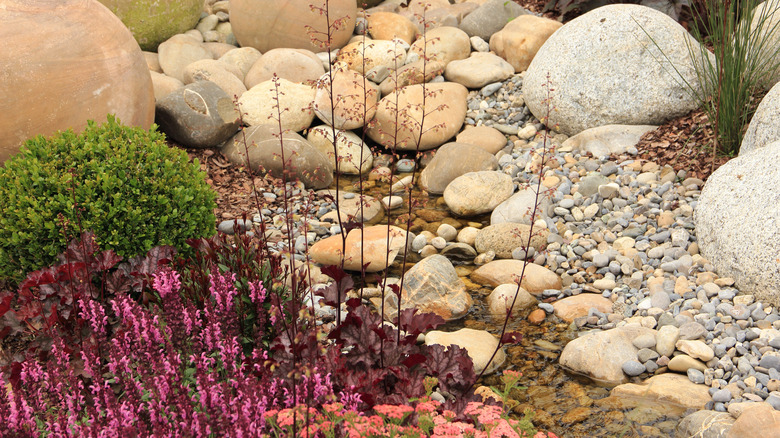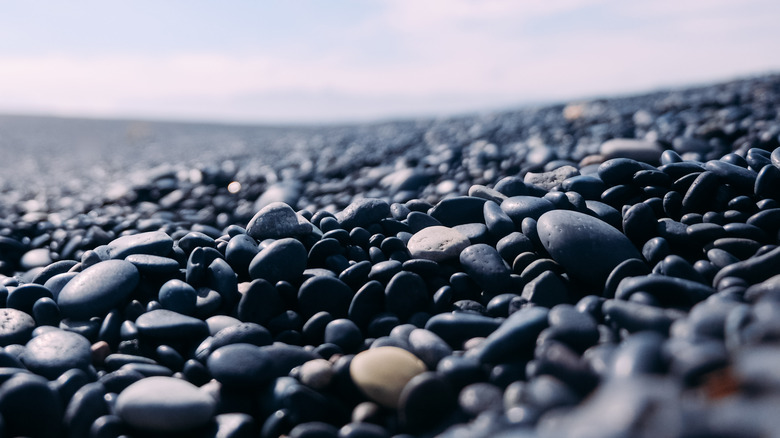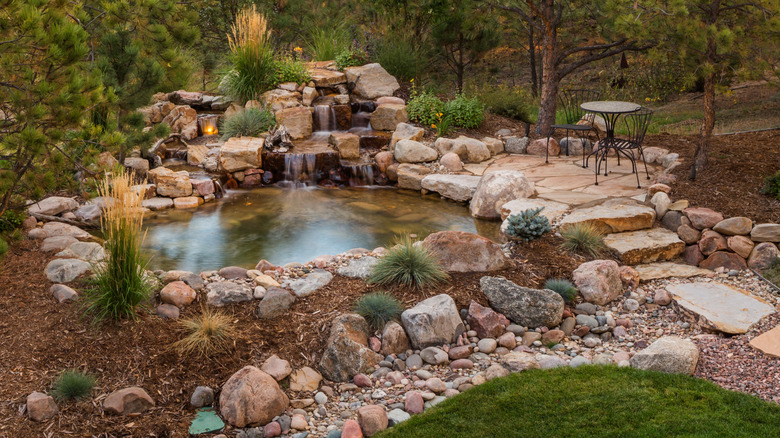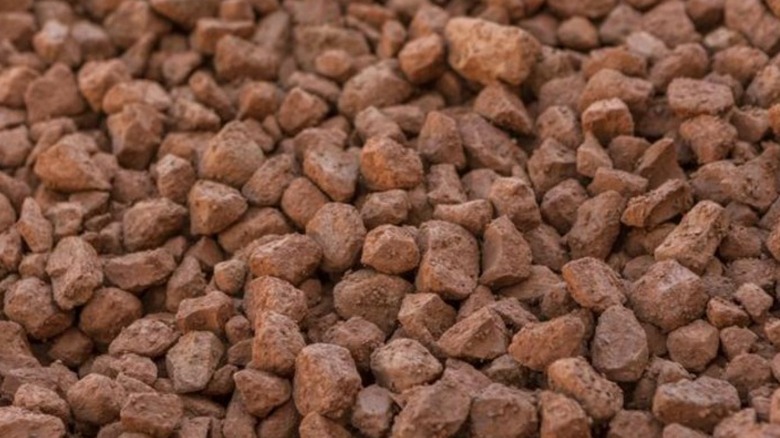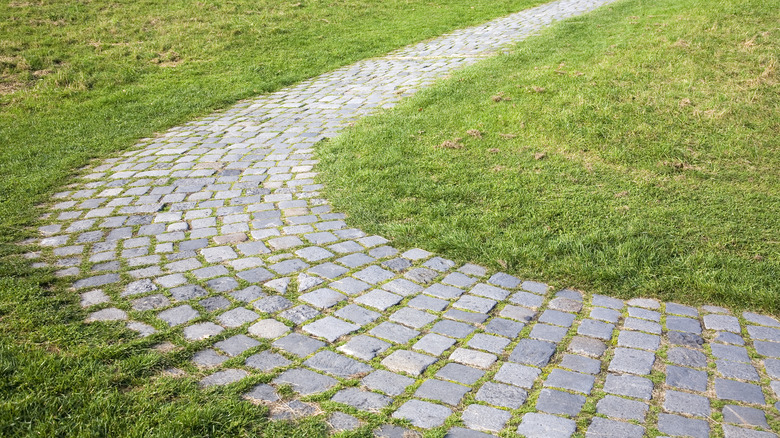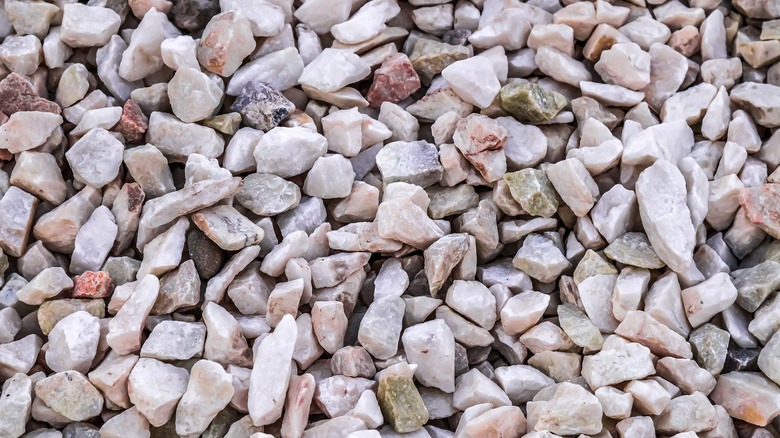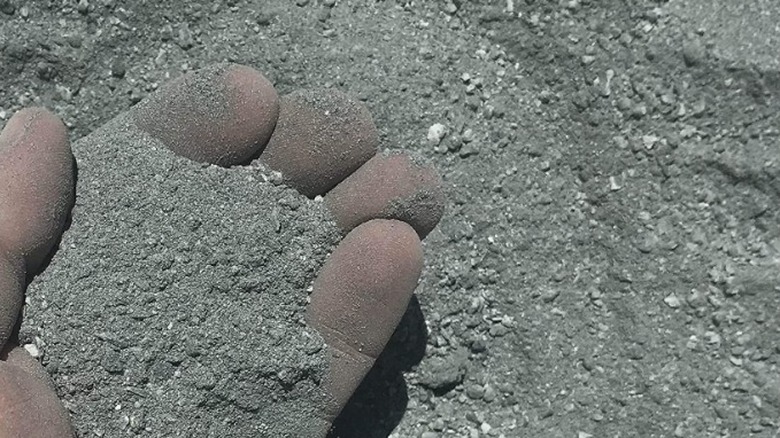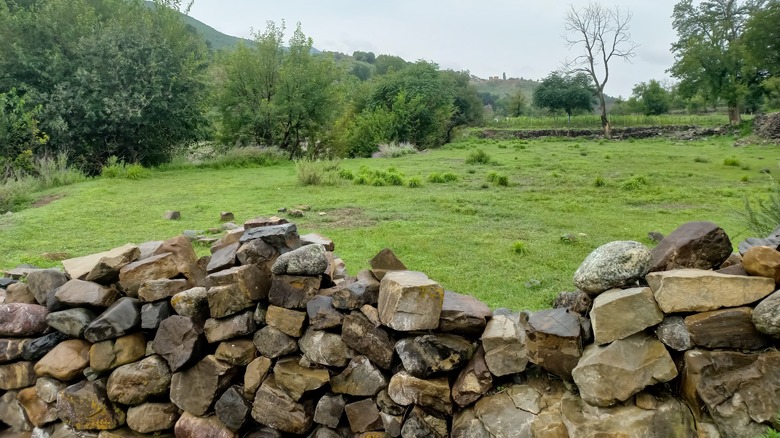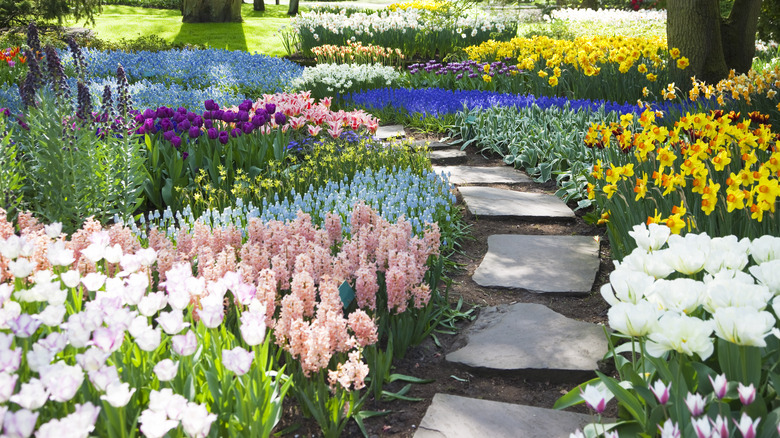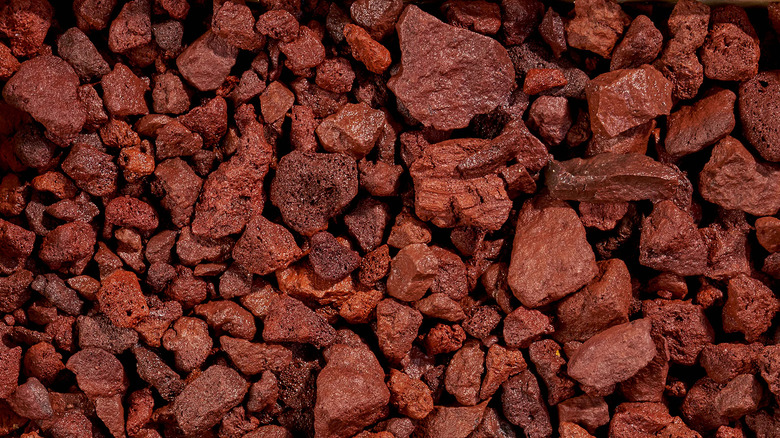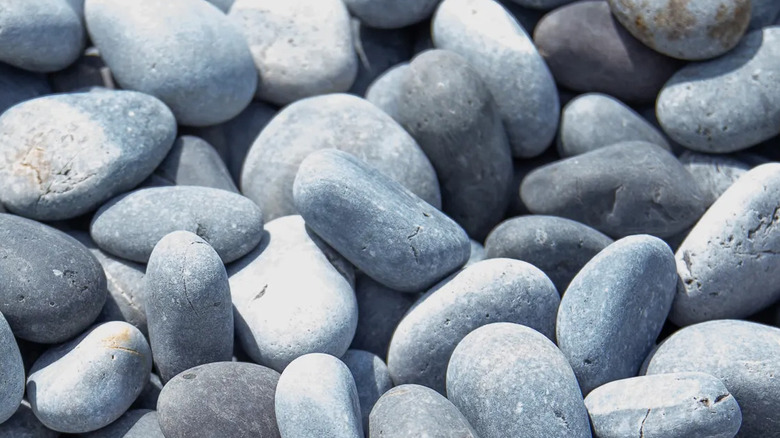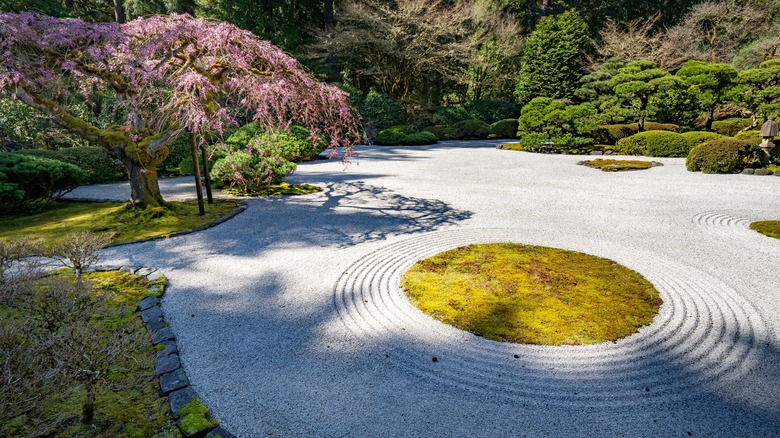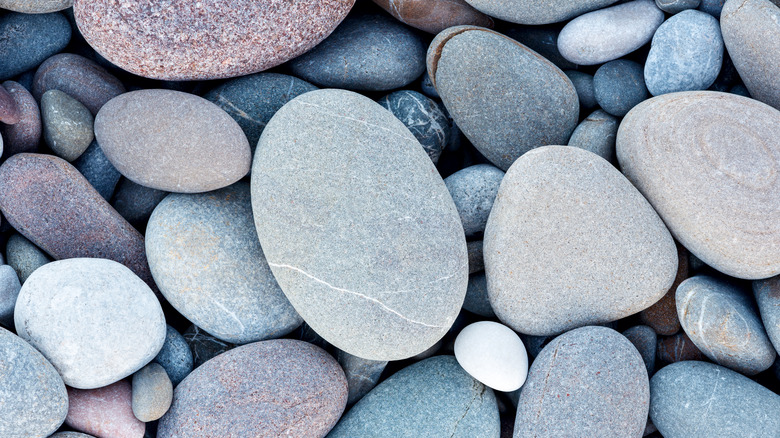Different Types Of Rock To Use In Landscaping
We may receive a commission on purchases made from links.
If you think a rock is just a rock, hold onto your hat because we have news for you. There are a lot of rock options to choose from when designing your landscape, and each one will bring a different kind of vibe to the scene. Some stones are neutral, while some are full of color. Some are smooth, and some are porous and sharp. Some are larger than a shrub, and others are teeny tiny. These differences are important because a cultivated landscape is an art installation. Much like a mixed media affair composed of a combination of paint, collage, canvas, and cloth, the best garden combines textures and colors alongside organic and inorganic matter.
Rocks have their rightful place in your landscape, just as the flowers and trees do. And just as you would with vegetation, you'll want to incorporate various sizes and shapes, using them in a variety of ways. For instance, one of the best things about using small rocks to form a border around a garden is that the result acts as a frame to hold and highlight your masterpiece. Meanwhile, oversized boulders can be used on their own as accent pieces or to build larger installations like waterfalls and bridges. Here are some of the most popular options to consider.
Black polished pebbles
To start things off on a bit of a dramatic note, there are black polished pebbles. These are stones that are run through a rock tumbler with an abrasive grit so they become smooth and rounded, reminiscent of what you would find along a stream bed in the mountains. These attractive rocks can stand in for mulch if you're looking to create a sleek and modern effect instead of something rustic, and they won't need to be replaced each season. If you lay down black landscaping fabric under the rocks, the two layers will blend together, and you won't notice bare patches as much as you would with mulch.
Depending on where you buy them, you should be able to purchase black polished pebbles in different sizes ranging from 1 inch to 5 inches. Mixing and matching will allow you to build extra layers of depth, or you could stick to one size for a more cohesive design. One issue to bear in mind is that the sheen will deteriorate over time due to direct sun exposure and inclement weather.
Boulders
For those with an expansive landscaping project, consider going big to fill up the space with natural elements. And we're not only talking about tall trees. You can purchase large boulders and have them delivered to your house and professionally installed. Use boulders to design a waterfall and koi pond, then line a pathway back to the house with them. Imagine how enjoyable it will be to relax the day away perched on an enormous rock, listening to the meditative sound of flowing water.
Even if you only have room or the budget for one or two boulders, situate them effectively as accent pieces to offset an otherwise uninteresting yard. Just as you would hang an ornate chandelier or a massive piece of artwork inside your home, a strategically placed boulder in the landscape will make quite a statement. Once you've decided on the best placement, you or the landscaping company will need to dig into the ground first so that part of the rock is buried. This will help keep it steady and make it look authentic, as if it was always there and you built everything else around it.
Brick chips
Are you ready for some red? True to their name, brick chips are small pieces of broken bricks. They are very easy to maintain and colorfast, so they won't fade over time. Just remember that brick materials absorb water and heat. This is an important detail if you plan to use them by vegetation, since the absorbed heat will continue to warm the soil overnight. Use it near plants that like it hot and can handle a little bit of drought. Bricks are naturally porous, so to keep weeds from sprouting through, use landscape fabric on top of the soil.
That bright red hue may be enticing at first, but if you use too much, it can turn into a drawback. Ultimately, brick chips should be used sparingly as accents or in conjunction with other warm tones in an appropriate desert-vibe environment. For example, they look amazing in a xeriscaped garden.
Cobblestones
Grayish blue cobblestones invoke a rich history of the oldest Roman roads and Victorian England thoroughfares. Their surfaces are smooth, and they were originally collected from river beds. When used in a landscape, cobblestones are a natural choice for creating clear, walkable pathways that allow blades of grass to poke their way up and fill in the gaps. You can also arrange different-sized stones into geometric patterns or other designs. They are very durable, making them suitable for a high-traffic area.
Interestingly, a study conducted by the Oregon Research Institute found that walking on the uneven surfaces of cobblestones improved the balance and reduced the blood pressure of participants. Cobblestone walking harkens back to the ancient Chinese practice of reflexology, which involves exerting pressure on specific parts of the foot to heal systemic and organ-related health issues. Who'd have thought that we could turn our landscape into something so beneficial to our health?
Crushed marble
Crushed marble rocks offer a bright and elegant twist on what could otherwise look like a sea of gray. Create a curved effect around your lawn with the bright white rocks by using edging to keep everything in place. First, dig a shallow trench in the shape you want. Then, install a simple plastic edging and fill the trench with 3 to 5 inches of aesthetically pleasing rocks. This will provide texture and a nice-looking contrast against the green of the lawn.
These rocks are not only decorative but are also a good mulch substitute. Just like wood chips, crushed marble discourages weed growth and protects the root systems of the plants you want, provided those plants like their soil to remain warm — which is exactly what the rock installation will guarantee. However, this rock option is not appropriate for acid-loving plants (azaleas, rhododendrons, gardenias, blueberry bushes, etc.) because it causes the soil around it to become alkaline.
Decomposed granite
Speaking of that sea of gray — sometimes it really is the best way to go. Decomposed granite is one of the more basic and economical options for landscaping stones. This type of granite is considered a fine gravel because it's made up of small particles (each less than ½ inch across) of igneous rock. The igneous rock will likely come from the vicinity in which you buy it, so you can expect it to match and blend naturally into the rest of your landscape.
A surface covered in decomposed granite will remain permeable, allowing rainwater to sink back into the ground where it belongs, rather than turning into runoff that causes problems elsewhere in your yard. Since it's low cost (one cubic yard will cost around $40 to $50), you can use it to cover large areas like patios or driveways. It's also a great option for lining a walkway that opens to a fire pit and seating area.
Fieldstone
Fieldstones get their name from the fact that they're found in fields. If you think about the old stone walls you come across on farms throughout New England (like what's shown above), you'll get the picture of what we're talking about. Fieldstones can be collected and used in a number of ways, but building a simple wall may be the most straightforward. For the more industrious landscapers, you could use them to make a walkway or a bridge over a pond feature.
Fieldstones do not get cut or manipulated in any way, so they're going to vary the most when it comes to shape and size. You either have to make do with whatever you find, or keep searching until you gather enough that are similar to create the design you have in mind. Working with this medium will give your yard a somewhat rustic and decidedly bucolic aura.
Flagstone
Flagstone designs are as old as the Vikings of the Iron Age, who used them to build forts and brochs (large round towers). Flagstones are quarried from underground, and while their surfaces will always be smooth and flat, their shapes can be dimensional or irregular. Dimensional flagstone has been cut using lasers and diamond blade saws to create straight lines and squared corners. They can be found in different sizes and laid in cohesive patterns for patio floors, walkways, and even driveways. Irregular flagstones can be used similarly, but the designs will be random and require fillers like gravel for the inevitable spaces left between the varied shapes.
Irregular flagstone is the obvious go-to for a walkable yet nature-inspired path through any type of garden. Like cobblestones, flagstones will allow a little bit of nature to pop up between each step. However, unlike cobblestones, they will be wider and more unison in level. Walking on them may not improve your balance, but it will be easier and less accident-prone.
Lava rocks
Adventurous types might fancy something that originates in the core of a volcano. So how about lava rocks to spice up your landscape? Sure, you can settle for black lava rocks, but they may look a little too much like charcoal briquets from the grill. Red lava rocks will bring a flare of crimson to the yard, similar to brick chips. No matter their color, one thing that's great about these rocks is that they are lightweight. They're naturally porous but also have air bubbles running through them, making them lightweight.
You can use lava rocks in place of mulch or to create a striking border around a garden bed. If you like the look but don't want to go so far as to build a walkway with them, lava rocks retain heat and are, therefore, perfect for fire pits. Note that the air pockets give them uneven surfaces, so they are prone to catching and holding onto pollen and moss. Pressure wash them or spray them with disinfectant to keep them clean.
Mexican beach pebbles
Maybe you're looking for gray rocks, but you want smoother and larger options than fine-grain decomposed granite. This is where Mexican beach pebbles come to join the landscaping party. Just consider how well these will work as a neutral background that will allow colorful foliage and flowers to really pop.
Originally collected from the cliffs lining the beaches of Baja, Mexico, these pebbles get their smooth and rounded surfaces from the effects of the wind, the waves, and the abrasive polishing capabilities of sand. Mexican beach pebbles will be a more expensive option than crushed stone or gravel, but the sleekness they offer will be worth the price. They come in a range of sizes, with the smallest (½ to ¾ inch) usually feeling comfortable underfoot. Use them as soil toppers in large planters, to line pathways, or to cover bare areas of ground near the bases of trees.
Pea gravel
Can you say Japanese zen garden? Pea gravel combines the crushed with the smooth as well as the economical with the visually appealing. You really can't go wrong with this versatile rock. Pea gravel strongly resembles Shirakawa-suna, the most authentic choice for a Japanese garden, so it's the best contender when you can't get your hands on the real deal. And how did it get its name? Well, individual pieces of pea gravel are about the size of a little green pea. Of course, they're not green themselves, though. You'll find them in shades of white, gray, or brown.
Think of pea gravel as purely decorative — it won't feel good to walk on barefoot, and it doesn't make for a sturdy enough surface to hold outdoor furniture. Even though it's not a first choice for high-traffic areas, it's a beautiful and low-maintenance option for any spot that could use a little visual enhancement. With your pea gravel in place, all you'll need to do is gently drag a rake through it to create satisfying waves and circular patterns. You can deconstruct these patterns and build them again whenever your heart desires a bit of mindful meditation in the garden.
Smooth river rocks
To create a soothing landscape that makes you feel like you're relaxing at a luxury spa, smooth river rocks are undoubtedly the option of choice. These large rounded rocks come from stream and river bed bases, where the flowing water creates their incredibly smooth texture. You'll find them in varying shades of blueish-gray, brown, and beige.
River rocks can be used in a practical sense to stabilize a rain garden, or in a purely decorative sense to design a mosaic. Because they're associated with all things aquatic, they'll also fit perfectly in any water feature you have, be it a fountain, a waterfall, or a pond. One word of caution is to remember that river rocks absorb a lot of heat. If your yard receives nonstop direct sun exposure, they can become too hot to walk on barefoot or touch with your hands. Pricing will vary, but note that river rocks will be more expensive than the other options.
